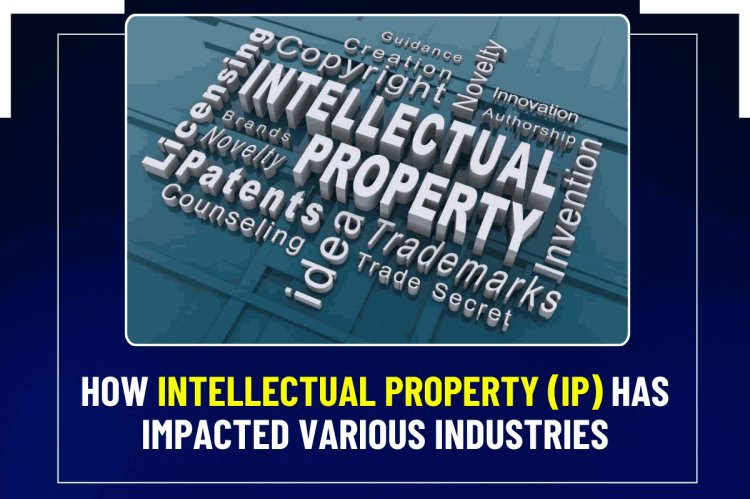How Intellectual Property (IP) Has Impacted Various Industries
Intellectual Property (IP) plays a crucial role in shaping industries across the globe, enabling businesses to protect their innovations, creations, and brand identities. In this blog, we explore how IP has impacted various sectors such as technology, pharmaceuticals, entertainment, fashion, and agriculture. By ensuring legal protection for innovations and creativity, IP laws promote economic growth, encourage innovation, and protect businesses from counterfeiting and infringement. We will look at examples and analyse how different industries have benefited from strong IP protection, as well as the challenges they face.

Introduction
Intellectual Property (IP) has become a vital asset for businesses and industries in the modern economy. As industries continue to innovate and expand, IP rights serve as a legal safeguard for their innovations, designs, brands, and creative works. Whether it’s the technology sector leveraging patents, the entertainment industry protecting copyrights, or agriculture securing plant varieties, IP is central to sustaining innovation and fostering competitiveness. This blog will explore how IP has impacted various industries, highlighting both the advantages and challenges they face in the realm of IP.
Impact of IP on the Technology Industry
The technology industry is IP-intensive, with patents, copyrights, and trade secrets playing a key role in driving innovation. Companies like Apple, Samsung, and Microsoft invest heavily in R&D to develop new products, and their success is largely attributed to their robust patent portfolios.
- Patents protect technological innovations, allowing companies to monopolize their inventions for a certain period, encouraging further investment in R&D.
For instance, Qualcomm, a leader in wireless technology, holds numerous patents on 4G and 5G technologies. By licensing these patents to other companies, Qualcomm generates billions in revenue while advancing the overall telecom industry.
- Trade Secrets: Technology companies also rely on trade secrets to protect algorithms, software codes, and proprietary processes. For example, Google’s search algorithm is a closely guarded trade secret that is critical to its market dominance.
Challenges: Patent Trolls: One major challenge in the tech sector is the rise of patent trolls—entities that acquire patents not to use them but to sue companies for infringement, stifling innovation and burdening companies with litigation.
IP in the Pharmaceutical Industry
The pharmaceutical industry is heavily dependent on patents to protect new drugs and medical technologies. Patents provide pharma companies with market exclusivity, allowing them to recover the significant costs of drug development.
- Drug Patents: Companies invest billions in the development of new drugs, which may take years of clinical trials and testing before approval. Patents help these companies prevent generic competition and enable them to earn profits during the exclusivity period. For example, the patent for Pfizer’s Lipitor, a leading cholesterol medication, generated over $125 billion in revenue during its patent-protected years.
- Generic Drugs: Once a drug’s patent expires, generic manufacturers can produce cheaper versions, making essential medications more accessible to the public. This balance between patent protection and eventual generic entry helps foster both innovation and public health.
Challenges: High Drug Prices: One criticism of IP in the pharmaceutical industry is the high cost of patented drugs, making life-saving medications inaccessible to many, especially in developing countries. This raises ethical concerns about the balance between innovation and affordability.
IP in the Fashion Industry
While the fashion industry may not be as heavily reliant on patents as tech or pharma, design protection, trademarks, and copyrights are essential tools for fashion brands to protect their creative designs and brand identity.
- Design Protection: Designers use design registrations to safeguard the unique look of clothing, accessories, and footwear. For instance, Christian Louboutin’s red sole is trademarked, preventing competitors from replicating this iconic design feature.
- Copyright: High-end fashion brands also use copyright to protect prints, patterns, and artistic elements applied to garments. Louis Vuitton fiercely protects its monogram pattern, which is a symbol of luxury and exclusivity.
Challenges: Design Piracy: The fashion industry faces rampant design piracy, especially in fast fashion where designs are quickly copied and mass-produced at lower prices. Despite legal protections, enforcing IP rights globally remains a challenge due to the speed at which designs are replicated.
IP in the Entertainment Industry
The entertainment industry relies heavily on copyright law to protect creative works such as films, music, books, and television shows. Copyrights provide creators with exclusive rights to distribute, reproduce, and perform their work.
- Film and Music Industry: Major film studios and music labels rely on copyright to protect movies, songs, and scripts from unauthorized distribution. Streaming services like Netflix and Spotify have revolutionized how content is distributed, making copyright enforcement even more critical as piracy remains rampant in the digital space.
- Copyright Royalties: Artists, authors, and composers also benefit from copyright royalties, ensuring they receive fair compensation for the use of their works. Taylor Swift, for example, re-recorded her earlier albums to reclaim ownership of her music catalog, highlighting the importance of copyright in protecting artists’ rights.
Challenges: Digital Piracy: One of the biggest challenges in the entertainment industry is combating online piracy. Despite the introduction of Digital Rights Management (DRM) and anti-piracy laws, illegal downloading and streaming of content continues to undermine revenue.
IP in the Agriculture Industry
IP plays a significant role in the agriculture industry, particularly in the development of new plant varieties and genetically modified crops. Patents, plant variety protections, and geographical indications (GIs) are the main forms of IP that impact the agricultural sector.
- Plant Variety Protection: New hybrid seeds or genetically modified crops can be patented, allowing companies to recoup investments in agricultural research. Monsanto, for instance, holds patents for its genetically modified seeds, which have revolutionized crop yields but also sparked debates on farmers’ rights and food security.
- Geographical Indications (GIs): GI protection is particularly important in agriculture. Products like Darjeeling Tea, Basmati Rice, and Nagpur Oranges are recognized under Geographical Indications laws, ensuring that only products from those specific regions can use the name, preserving their unique heritage and promoting regional economies.
Challenges: Farmers’ Rights: One of the criticisms of patents in agriculture is the impact on small farmers, who may struggle to afford patented seeds or be restricted by licensing agreements.
Conclusion
The role of Intellectual Property in various industries is undeniable. From driving innovation in tech and pharma to protecting creativity in fashion and entertainment, IP has a significant impact on how industries operate and evolve. However, challenges such as patent trolls, piracy, and affordability remain ongoing concerns that require attention. Striking a balance between protecting innovators and ensuring accessibility is key to fostering a fair and thriving global economy.
As industries continue to innovate, robust IP laws will be crucial in maintaining their competitiveness while ensuring sustainable growth and fair competition.












